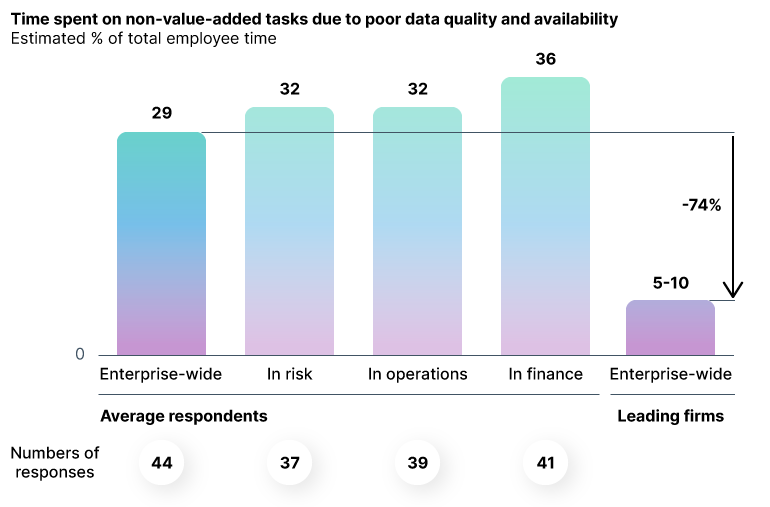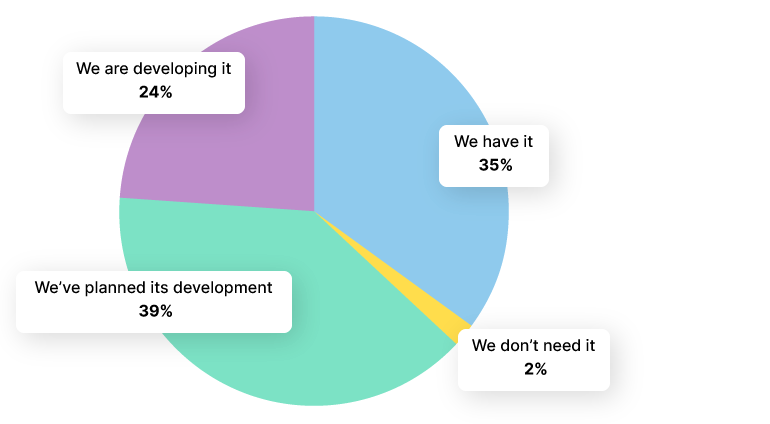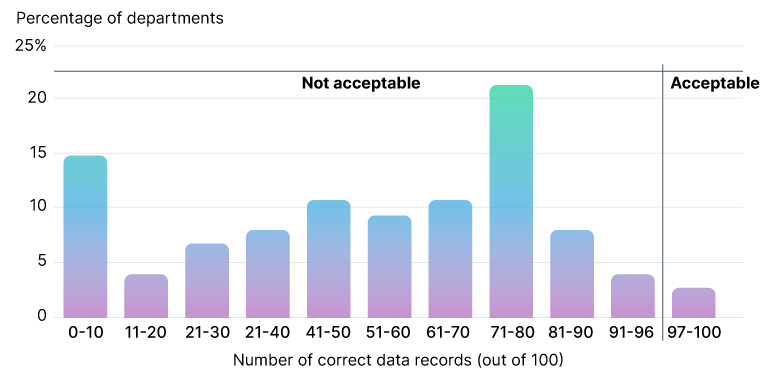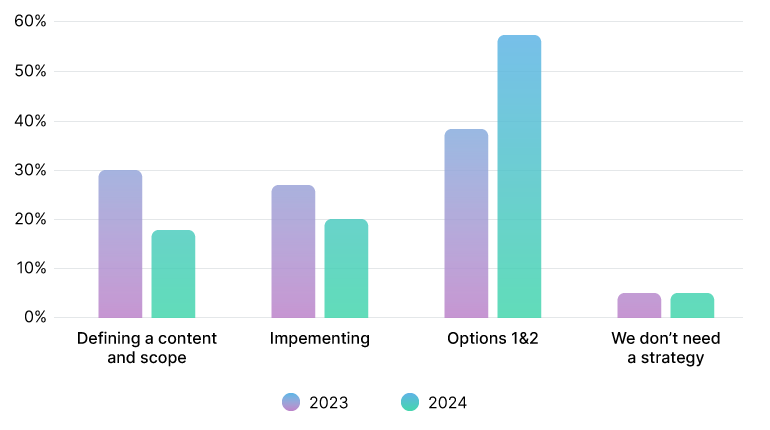A data management strategy is much more than your data handling practices; it can increase productivity and help you implement advanced technologies such as AI. Simply put, you will gain a significant competitive advantage by eliminating chaos and utilizing all the opportunities available to the company. According to a McKinsey report, 82% of respondents at global organizations spend one or more days per week resolving data quality issues. The right strategy can fix this.
Intellias understands the importance of creating and implementing a data management strategy and ensuring that it aligns with your business goals. Let’s look at what a data management strategy is, its benefits, how to develop a data management strategy, and what challenges may await you along the way.
Data Management Strategy Benefits
Having all the data at your fingertips and structuring it properly are synonyms for efficiency.
In turn, the challenges that follow from the inefficient use of data aren’t so obvious, although many people face their consequences.
| Benefits of data management | Challenges of data management |
|---|---|
|
|
The benefits of a data management strategy can significantly reduce the associated risks. It can increase the effectiveness of data by transforming it into intelligence to draw conclusions and predictions.
Problem:
Teams need to understand the direction of work in data analytics. Different teams don’t understand the overall focus of the work and systematically fail to meet deadlines. Top management is unable to identify problems that require transformation at the company level and cannot be solved within a single project.
Solution:
Identifying key business objectives is a key step in developing a data management strategy. The data management strategy involves establishing clear performance metrics and continuous performance reports. This way, your data becomes intelligence, i.e. the basis for making global decisions about the development of the company.
Problem:
Data decentralization. Data is difficult to integrate and analyze as it is stored in different formats or/and different systems. Data is incomplete, inaccurate, or inconsistent. It can lead to poor decision-making.

Source: McKinsey Global Data Transformation Survey, 2019
Solution:
By implementing a data management strategy, you ensure that a unified ecosystem is created. Each stage of the information lifecycle in the company is regulated. Stakeholders can easily access it, analyze the situation based on it, and make an informed decision for the best possible outcome.
Problem:
Excessive manual work and lack of transparency. Employees spend too much time searching for data, which reduces their productivity. It’s unclear what happens to data, who has access to it, and how it changes, which can lead to problems with certification compliance.
Solution:
To prevent data from being lost, it can be aggregated into convenient and comprehensive databases supported by specialized tools. The strategy will help to collect, store, and organize the available data and automate routine work. When the data management strategy works, there is a clear list of who has access to information and who is responsible for working with it.
5 Steps to an Effective Data Management Strategy
Developing a data management strategy can be time-consuming and requires a high level of expertise.
However, everything is possible with Intellias experts. Let’s take a look at how we create a data management strategy in 5 key steps.
Identify business objectives
A Data Crossroads survey states that 98% of companies consider the necessity to create a data management strategy. However, to do it, you need to clearly understand why you need it and what data you need to achieve it.
Typically the key questions asked at this stage are as follows:
- What are the overall goals of your business?
- What data do you need to achieve those goals?
- What insights do you need to gain with this data in hand?
By answering these questions, you will be able to determine the vector to follow, the tools you need, and the KPIs for the effectiveness of the strategy.
The status of a data management strategy

Source: Data Crossroads
Examine your data processes
So, it’s clear why you need the data. But what about its quality? Harvard Business Review states that only 3% of companies’ data meet basic quality standards even though managers usually rate it as 90%+.

Source: Harvard Business Review
To do it you have to define the main processes in which this data is involved. In particular, identify the owners and stakeholders in the following steps:
- Collection
- Storage
- Analysis
- Distribution
- Archival
- Destruction
This will allow you to clearly understand who the information passes through at each stage and why the use of the data doesn’t bring the desired results.
Find the right technology
We can draw up a redundant list of both cloud and on-premise solutions, but there is no point in it. Technologies should be tailored to each specific business based on its needs and goals.
Entrusting the selection of specific solutions to the specialized vendor can ensure that the strategy will work within a unified system and bring the expected results.
Appoint data management roles
Implementing a data management strategy requires a whole bunch of highly specialized experts. The success of the project depends on their professionalism and teamwork.
In particular, you need:
- Data architects
- Data modelers
- Database administrators
- Database developers
It is time- and resource-consuming to gather all these specialists in your team. Instead, you can rely on an implementation partner.
Intellias has a comprehensive suite of end-to-end data management capabilities and a diverse team of experts. Our comprehensive expertise enables us to deliver seamless, integrated data strategies tailored for both enterprise and midmarket clients across various industries.
How Intellias provided data strategy guidance for a global construction brand
We were approached by a large company group providing a full range of building construction services. The client had accumulated a large amount of data from various sources and integrations over the years.
Chaos in data management was hindering the company’s development. The large amount of disparate information required too much time to find the right insights.
The client urgently needed to optimize data governance processes for further work and to structure the existing data. The Intellias team onboarded the client’s team and started to develop a data governance strategy.
MS Azure Services and Power BI were chosen as the core technologies for this assignment.
In the framework of strategy development, we carried out the following activities:
- Held meetings and workshops with the client’s team to identify functional and non-functional requirements.
- Based on the goals and risks we developed the architecture of the future system.
- Outlined the CI/CD pipeline, documentation flows, and DevOps guide.
- Created an MVP of key system components to implement the data management strategy. This includes a new data warehouse as well as customization of infrastructure components responsible for data loading, processing, and modeling.
- Integrated the Carusso API data protection solution with the Azure Synapse analytics service.
All of this laid a solid foundation for implementing a data management strategy. Right now we are continuing to work with the client on its implementation.
Ensure data accessibility
Another important aspect of developing data management strategies is the designation of responsible stakeholders. By giving the necessary authorizations it will be clear who is responsible for each of the strategy implementation stages.
Intellias creates a data management strategy roadmap for this purpose, which includes the following building blocks:
- Objectives
- Timeline
- Software
- Responsibility Assignment Matrix (RACI)
- Required investments
Produce documentation
You need all employees to act according to your strategy. After all, data-driven organizations are 23 times more likely to acquire customers. That’s why it’s extremely important to create detailed data handling documentation to achieve it.
Having a clear list of methodologies and regulations for your employees will greatly increase the effectiveness of your strategy. At the same time, the amount of chaos when dealing with valuable data will inevitably decrease.
Adapt to data culture
Finally, it’s necessary to create a self-sustaining system to keep the strategy alive. This can be achieved by implementing a proper data culture.
Employees should:
- View enterprise data as a reliable source
- Understand the importance of preserving company data
- Implement data management templates
- Improve their data practices
Challenges with a data strategy

Source: Data Crossroads
When the importance of data is understood by all employees, not just the analytics department, the company’s productivity can increase dramatically.
Data Management Strategy Examples
Financial Services
Data management in the financial services industry has the potential to drastically change the analytics and predictive processes.
Intellias has a successful example of implementing a data management strategy for a loan business. During this project, we managed to achieve a 10% reduction in manual actions per case due to an automated data collection process. In addition, we increased cost efficiency through customized data infrastructure by 20%.
Retail
A data management strategy in retail helps to analyze performance, gain valuable insights into trends, and prepare the business to enter new markets.
One of Intellias’s projects was to build a big data platform to process data for a large chain of stores.
The solution is capable of receiving real-time data analytics across 125 stores, which was beneficial to marketing and the client’s ability to make timely decisions. In addition, the platform helped to reduce energy consumption across the supermarket chain by 20%.
Automotive
In the automotive industry, a good data management strategy leads to improvements in both production processes and subsequent product sales.
Intellias’s successful data management strategy example is the creation of a B2B data processing platform with deep analytical and predictive capabilities. We created a solution that collected and processed data in the European region. This allowed the client to track transactions in real time and collect data from different sources in different formats.
Manufacturing
In manufacturing, a data management strategy can provide predictive analytics and prevent critical issues.
One of Intellias’s projects is a predictive maintenance solution for manufacturing hubs. With IoT technology, we provided real-time data collection and 100% equipment uptime.
Best Practices for Implementing a Data Management Strategy
Join forces
Creating an effective data management strategy requires collaboration between all stakeholders.
This includes top management, employees, and of course the partners responsible for developing and implementing the strategy. Only by gathering the right people and defining their needs and areas of responsibility, it’s possible to successfully develop an action plan.
This will greatly simplify the work of the chief data officer (CDO) and clearly outline the goals and purpose of the strategy.
Determine what data you have
To understand how to improve your data management strategy, you need to clearly understand what you can operate on and what gaps to fill. A detailed list of the information you have will allow you to set goals and realistic resources.
Based on this list, you will identify the tools, potential uses for the data, and the infrastructure required.
The list will then greatly aid in discovering, collecting, managing, and analyzing data. These processes can then be integrated into an overall strategy and acted upon.
Provide clear shared value
A mechanism won’t work if all the gears aren’t turning smoothly. For a data strategy to be implemented and deliver real value to employees, they must understand exactly how it will improve processes.
Outline common use cases, such as automating processes, improving productivity, freeing up human resources, etc.
Once they understand the overall value, employees will work to ensure the strategy is successfully implemented, creating a self-sustaining process. This is the key element of creating a data culture.
Implement the strategy gradually
The market is constantly changing, and conditions and technologies are evolving. For example, a couple of years ago, AI was just a curious novelty, interesting only to technology startups and industry giants trying to buy them.
Data management strategy should be introduced gradually. This will make it possible to make the necessary adjustments in the face of new emerging factors. The main goals allow us to outline the general direction of development and move towards it while maintaining flexibility based on the resources available.
Measuring the Success Of Your Data Strategy
To understand how to implement a data management strategy, there has to be clear success criteria measurement. Based on these criteria, it will be possible to decide whether everything is working properly or whether the strategy needs to be reviewed and adjusted. This includes:
- Increased employee productivity
- Improved customer satisfaction
- Reduced costs
- Increased revenue
- Reduced decision-making time
- etc
The key element of implementing a data management strategy is an improved understanding of the vector towards your company’s development. If after a certain period, you have an accurate and clear report on the increased efficiency of your business, then the data management strategy is working.
Rely on Intellias With Your Data Management Strategy Development
With 20+ years in the market, Intellias possesses the expertise and experience to support you in developing and implementing a robust data management strategy, acting as a dependable partner throughout the process. Our experts are ready to guide you in defining your business objectives, choosing the appropriate technologies, and ensuring the seamless implementation and ongoing support of your data management strategy. Contact us today to transform your data into a solid foundation for advanced analytics and AI model implementation, ensuring your business is primed for future challenges.


